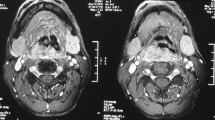Abstract
Purpose
Parastomal recurrence of squamous cell carcinoma (SCC) with tracheal involvement following salvage total laryngectomy after prior concurrent chemoradiotherapy is one of the most insidious challenges in head and neck surgery because a complex reconstruction is often required for covering a large area of skin loss, filling the dead space beneath, tracheal reconstruction and suspension, and tracheostome resurfacing. The aim is to describe our experience with the internal mammary artery perforator (IMAP) propeller flap for tracheal and tracheostome reconstruction and neck resurfacing after parastomal and cervical trachea resection, especially for suspension and anchoring the stump of the residual distal trachea to the island flap itself.
Methods
We describe IMAP flap reconstruction after resection of parastomal recurrence of SCC requiring cervical trachea resection in five patients between January 1, 2005 and August 30, 2019.
Results
IMAP propeller flap was successfully used for reconstruction after complex resection of parastomal recurrence of SCC with cervical trachea involvement in all cases. The mean length and width were, respectively, 16.8 cm (range 13–23) and 6.9 cm (range 5.5–8). We did not report complications of both the donor and the recipient site. Pharyngo-cutaneous or tracheoesophageal fistulas and wound dehiscence were not observed.
Conclusions
to the best of our knowledge, this is the first report about the use of the IMAP propeller flap in this more complex clinical setting and we provide the message that this surgical procedure is worthy of consideration.



Similar content being viewed by others
References
Wang ZY, Li ZQ, Ji H et al (2017) Influence of risk factors on stomal recurrence after total laryngectomy for laryngeal carcinomas: a meta-analysis. J Cancer Res Ther 13(5):856–861. https://doi.org/10.4103/jcrt.JCRT_90_17
Kowalski LP, Rinaldo A, Robbins KT et al (2003) Stomal recurrence: pathophysiology, treatment and prevention. Acta Orolaryngol 123:421–432. https://doi.org/10.1080/00016480310000683a
Caliceti U, Piccin O, Cavicchi O, Contedini F, Cipriani R (2009) Anterolateral thigh free flap for tracheal reconstruction after parastomal recurrence. Head Neck 31:1107–1111. https://doi.org/10.1002/hed.20992
Sisson GA, Goldman ME (1981) Pectoral myocutaneous island flap for reconstruction of stomal recurrence. Arch Otolaryngol 107:446–449. https://doi.org/10.1001/archotol.1981.00790430048013
Pittman A, Lindau R, Andersen P, Wax MK (2014) Stomal recurrence: salvage surgery and reconstruction utilizing microvascular free tissue transfer. Head Neck 36(10):1431–1434. https://doi.org/10.1002/hed.23468
Cina A, Salgarello M, Barone-Adesi L, Rinaldi P, Bonomo L (2010) Planning breast reconstruction with deep inferior epigastric artery perforating vessels: multidetector CT angiography versus color Doppler US. Radiology 255(3):979–987. https://doi.org/10.1148/radiol.10091166
Schellekens PP, Aukema TS, Hage JJ, Prevoo W, Kon M (2014) Can previous diagnostic examinations prevent preoperative angiographic assessment of the internal mammary perforators for (micro)surgical use? Ann Plast Surg 72(5):560–565. https://doi.org/10.1097/SAP.0b013e318268a896
Abdel-Monem K, Elshahat A, Abou-Gamrah S, Eldin Abol-Atta H, Abd Eltawab R, Massoud K (2012) Color duplex assessment of 4th and 5th internal mammary artery perforators: the pedicles of the medially based lower pole breast flaps. Eplasty 12:e4
Almadori G, De Corso E, Visconti G et al (2019) Impact of internal mammary artery perforator propeller flap in neck resurfacing and fistula closure after salvage larynx cancer surgery: our experience. Head Neck 41(11):3788–3797. https://doi.org/10.1002/hed.25903
Santoro R, Franchi A, Tempesti C, Sardi I, Polli G (2003) Stomal recurrence following total laryngectomy: clinical and molecular analysis of a series. Ann Otol Rhinol Laryngol 112:594–599. https://doi.org/10.1177/000348940311200704
Grillo HC, Mathisen DJ (1990) Cervical exenteration. Ann Thorac Surg 49(3):401–408. https://doi.org/10.1016/0003-4975(90)90243-y
Alberdas JL, Shibahara T, Noma H (2003) Histopathologic damage to vessels in head and neck microsurgery. J Oral Maxillofac Surg 61:191–196. https://doi.org/10.1053/joms.2003.50034
Al Qattan MM, Bowen V (1993) Effect of pre-existing health conditions on the results of reconstructive microvascular surgery. Microsurgery 14:152. https://doi.org/10.1002/micr.1920140304
Neligan PC, Gullane PJ, Vesely M, Murray D (2007) The internal mammary artery perforator flap: new variation on an old theme. Plast Reconstr Surg 119(3):891–893. https://doi.org/10.1097/01.prs.0000255542.35404.af
Funding
This research received no specific grant from any funding agency in the public, commercial, or not-for-profit sectors.
Author information
Authors and Affiliations
Corresponding author
Ethics declarations
Conflict of interest
The authors declare that they have no affiliations with or involvement in any organization or entity with any financial interest (such as honoraria; educational grants; participation in speakers’ bureaus; membership, employment, consultancies, stock ownership, or other equity interest; and expert testimony or patent-licensing arrangements), or non-financial interest (such as personal or professional relationships, affiliations, knowledge or beliefs) in the subject matter or materials discussed in this manuscript.
Ethics approval
The study was approved by the institutional ethical committee review board with the following number of protocol: 0028911/19.
Consent to participate
Informed consent was obtained at the time of original data collection.
Consent for publication
Authors obtained formal consent to publish the manuscript.
Availability of data and material
Derived data supporting the findings of this study are available from the corresponding author on request.
Code availability
Not applicable.
Additional information
Publisher's Note
Springer Nature remains neutral with regard to jurisdictional claims in published maps and institutional affiliations.
Rights and permissions
About this article
Cite this article
Almadori, G., Di Cintio, G., De Corso, E. et al. The usefulness of the IMAP propeller flap for trachea and tracheostome reconstruction after resection of parastomal recurrence of squamous cell carcinoma following salvage total laryngectomy. Eur Arch Otorhinolaryngol 278, 499–507 (2021). https://doi.org/10.1007/s00405-020-06168-4
Received:
Accepted:
Published:
Issue Date:
DOI: https://doi.org/10.1007/s00405-020-06168-4




